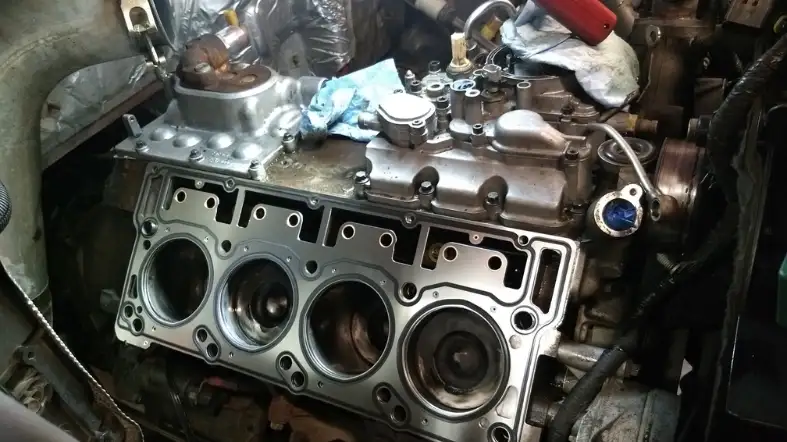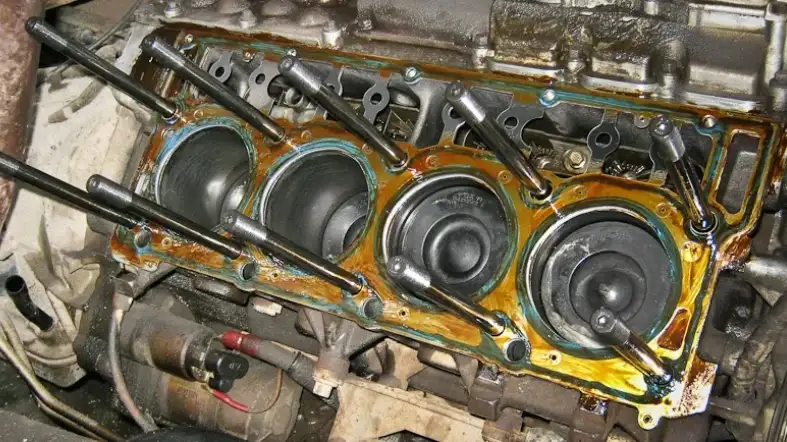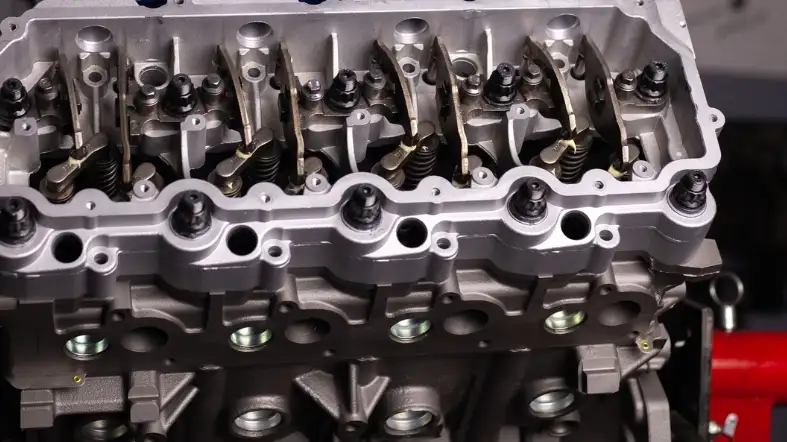If you’re a diesel truck owner, chances are you’ve heard of the notorious 6.0 Power Stroke engine and its issues with head gaskets.
While the engine itself is known for its power and reliability, head gasket failures can lead to costly repairs and downtime.
So, how much does it actually cost to replace a head gasket on a 6.0 Power Stroke engine? In this article, we’ll explore provide you with a comprehensive answer.
6.0 Head Gasket Replacement Cost
Head gasket replacement costs depend on several variables For example the make and model of the vehicle, the extent of the damage, and the location of the repair shop.

On average, one have to spend from $1,000 to $2,500.
However, some high-end luxury vehicles or trucks may have higher costs for head gasket replacement.
Factors That Affect The Cost Of A 6.0 Head Gasket Replacement
Below are the factors that affect the cost of 6.0 head gasket replacement
Labor Costs
The labor costs for a head gasket replacement can vary depending on the repair shop and location.
For instance, the labor cost for a head gasket replacement on a 6.0 Power Stroke engine is around $1000 to $1400.
Again the labor costs for a Ford F-350 Super Duty head gasket replacement ranges from $1,385 to $1,747.
Parts Costs
The cost of the replacement parts can also impact the overall cost of the repair.
The cost of a head gasket replacement kit and new head bolts for a four-cylinder boxer engine is around $207.
The cost of parts for a 6.0 Power Stroke head gasket replacement is estimated to be around $500 for studs, $350 for an upgraded EGR cooler, and the remainder in gaskets, coolant, and oil.
How To Choose The Right Parts For A 6.0 Head Gasket Replacement?

Here is how to choose the right parts for a 6.0 head gasket replacement:
1. Head Gasket Brand
When it comes to choosing a head gasket brand, Fel-Pro and ARP are popular choices for the 6.0 Powerstroke engine.
It’s important to choose a high-quality gasket that is designed specifically for your engine to ensure proper sealing.
2. Gasket Material
The material of the head gasket is also important to consider. Multi-layer steel (MLS) gaskets are commonly used for the 6.0 Powerstroke and provide good durability and sealing properties.
You can also use other materials, such as composite and copper.But before using make sure they are compatible with your engine.
3. Head Studs
Replacing the head gasket is a good opportunity to upgrade to stronger head studs, which can help prevent future gasket failures. ARP head studs are a popular choice for the 6.0 Powerstroke.
4. Other Parts
In addition to the head gasket and head studs, there may be other parts that need to be replaced during a head gasket replacement.
This can include items such as bolts, seals, and gaskets for the intake and exhaust manifolds.
It’s important to carefully inspect all components and replace any that show signs of wear or damage.
How To Properly Break In A New Head Gasket On A 6.0 Engine After Replacement?

Here are some steps to follow to properly break in a new head gasket on a 6.0 engine after replacement:
Step 1: Install the Head Gasket Properly
Ensure that the head gasket is installed properly by cleaning the bolt holes that tighten the head to the block and fitting the head gasket onto the block.
Use gasket sealant when specified by the manufacturer, and only use the directed amount in the particular places.
Step 2: Use the Right Parts
Using high-quality parts is important when replacing a head gasket.
Consider using heat-treated, high-strength custom alloy steel cylinder head studs like the PQx® #101420 Ford 6.0L Diesel Head Stud Kit to prevent head gasket failures.
Step 3: Properly Break in the Engine
Once the new head gasket is installed, it is important to properly break in the engine.
Follow these steps to properly break in the new head gasket: Start the engine and let it warm up.
Do not rev the engine during this time. After the engine is warm, accelerate it gently up to about 2,500 RPM. Then, coast back down to 20 miles-per-hour.
After repeating Step 3.2 a few times, accelerate the engine harder up to about 5,000 RPM.
Then, coast back down to 20 miles-per-hour.After completing Step 3.3, let the engine cool.
Change the oil and filter after completing the first few break-in miles. Drive the next 500 miles normally, keeping the engine below 5,000 RPM and minimizing operation at idle.
Step 4: Bleed the Cooling System
Before installing your new head gaskets, it’s always recommended to bleed your cooling system.
This will get rid of problematic air pockets that could otherwise heat up. That heat can transfer to your new gaskets, causing them to grow in size.
By following these steps, you can properly break in a new head gasket on a 6.0 engine after replacement and ensure the longevity and reliability of your engine.
What Are The Benefits Of Replacing A Head Gasket In A 6.0 Engine?

Below are some potential benefits to replacing a head gasket in a 6.0 engine.
Improved Engine Performance and Efficiency
Replacing a blown head gasket can help restore engine performance and efficiency.
A blown head gasket can cause a variety of issues, such as engine misfires, overheating, and loss of compression.
By replacing the head gasket, these issues can be resolved, and the engine can operate more efficiently and effectively.
Prevent Further Damage
A blown head gasket can lead to further engine damage if not addressed promptly.
For example, coolant leaks can cause overheating and potentially warp the engine block or cylinder head, resulting in expensive repairs.
Replacing the head gasket can prevent further damage and potentially save on repair costs down the line.
Better Gas Mileage
A properly functioning engine can operate more efficiently, which can result in better gas mileage.
A blown head gasket can cause the engine to run inefficiently, resulting in decreased fuel economy.
By replacing the head gasket, the engine can run more efficiently, which can lead to improved gas mileage.
Peace of Mind
Replacing the head gasket can provide peace of mind knowing that the engine is operating as it should.
A blown head gasket can cause a variety of issues and can be a significant source of stress for vehicle owners.
By replacing the head gasket, vehicle owners can be assured that their engine is operating correctly and can enjoy their vehicle without worry.
Frequently Asked Questions
Is It Recommended To Replace Both Head Gaskets At The Same Time?
Yes, it is recommended to replace both head gaskets at the same time to ensure that the engine is properly balanced and avoid future repairs.
Does The Type Of Head Gasket Used Affect The Cost Of Replacement?
Yes, the cost of replacement can vary depending on the type of head gasket used.
It is recommended to use OEM gaskets instead of cheap black onyx head gaskets.
How Long Does It Take To Replace A Head Gasket In A 6.0 Engine?
According to CoPilot, a head gasket replacement cannot be done in less than 6 hours, and may take several days depending on the severity of the damage and additional necessary steps.
Is It Necessary To Replace The Head Bolts When Replacing The Head Gasket?
Yes, it is recommended to replace the head bolts when replacing the head gasket to ensure that the engine is properly sealed and prevent future leaks.
Conclusion
The cost of replacing a head gasket on a 6.0 Power Stroke engine can vary widely depending on a variety of factors, including labor costs, parts costs, and taxes included.
While the general cost is around $1000 to $1400, the average cost for replacing a head gasket in our sample vehicles ranged from $3,456 to $5,459.
It’s important to choose a quality head gasket to ensure a long-lasting repair, and to do your research on the various options available on the market.
Ultimately, while the cost of replacing a head gasket on a 6.0 Power Stroke engine may seem high, it’s a necessary repair to ensure the longevity and reliability of your vehicle.
